Best Season for Mera La and Amphu Laptsa Pass
The best seasons for the Mera La and Amphu Laptsa Pass trek are the pre-monsoon (spring) and post-monsoon (autumn) periods. These seasons offer the most favorable weather conditions for trekking in the Nepal Himalayas, making them ideal for this challenging route as well.
Both spring and autumn provide relatively stable weather, clear skies, and better visibility, especially in April, May, September, and October, which are considered the best months for this trip. These months also offer suitable conditions for trekking and climbing with minimal risk of weather-related hazards.
However, it's important to keep in mind that mountain weather can be unpredictable, especially in remote and high-altitude areas. Sudden weather changes are always possible, so trekkers should be well-prepared, regardless of the season.
While both spring and autumn have their own unique advantages, the rest of the year is generally not recommended for the Mera La and Amphu Laptsa Pass trek. Summer (monsoon) brings poor visibility, heavy rainfall, and the risk of landslides along the trail. Winter brings extreme cold and heavy snowfall, which can increase the risk of delays or even make it impossible to complete the trek on time due to potential hazards.
Amphu Laptsa Pass Trek Difficulty
The Amphu Laptsa Pass Trek is considered one of the most challenging trekking routes in Nepal due to its long duration, high-altitude terrain, unpredictable weather conditions, and remote location. Trekkers must possess good physical fitness, overall good health, prior high-altitude trekking experience, and strong determination. To successfully complete the Mera and Amphu Laptsa Pass trek, you should be prepared to walk 5 to 10 hours a day, often on steep ascents and descents.
One of the major challenges of this trek is the high altitude, particularly for beginner trekkers. The journey starts at 2,800 meters in Lukla and reaches as high as 5,845 meters at Amphu Laptsa Pass via Mera La. Altitude sickness is a potential concern for anyone attempting to reach these elevations, and proper acclimatization is essential.
Regular physical exercise, prior trekking experience, and basic climbing training are highly recommended. However, if you are a beginner, it is crucial to undergo proper preparation, including fitness training and mental readiness, before attempting this trek.
Our experienced guides and support team will ensure you have the necessary clothing and climbing equipment. They will also arrange teahouse and tent accommodations, identify suitable rest stops, assist with climbing sections, and manage acclimatization days to help you adjust to the altitude. The guide will recommend a slow pace and short, steady steps to reduce fatigue and ensure a safe and enjoyable trekking experience.
Acclimatization to Reduce the Risk of Altitude Sickness
Acclimatization is essential for the Amphu Laptsa Pass Trek because the route involves trekking through high-altitude areas of the Himalayas. Once you ascend above 3,000 to 3,500 meters, altitude sickness becomes a common concern and can affect any trekker, regardless of fitness level. Symptoms of altitude sickness can develop quickly at these elevations, so taking the right precautions is crucial.
To minimize the risk, follow proper acclimatization practices such as: walk at your own comfortable pace, drink plenty of water, eat a well-balanced diet rich in carbohydrates, avoid alcohol, ascend gradually, and sleep at lower elevations whenever possible. Additionally, it is advisable to spend two nights at every 500-meter gain above 3,500 meters—especially if you ascend 500 meters in one day—to allow your body to adjust properly.
All of our trekking itineraries are designed with built-in acclimatization days to prioritize your health and safety. For the Amphu Laptsa Pass Trek, Khare Camp serves as an important acclimatization stop. The trek begins from Lukla (2,800 meters) and gradually gains elevation, including an early crossing of Zatrwa La Pass (4,689 meters) on the second day. This gradual ascent through forests and scheduled rest days help your body adapt naturally to the increasing altitude.
In case of serious symptoms, we provide essential medications and emergency support, including rescue if necessary. It's very important to inform your guide or trek leader of your health status daily. Based on their evaluation, they will decide whether it is safe for you to continue the trek or if further acclimatization or descent is needed.
Accommodations for Amphu Laptsa Pass Trek
Accommodations on the Amphu Laptsa Pass Trek vary in quality depending on the location—Kathmandu, Lukla to Khare, Khare to Chukung, and Chukung to Namche.
In Kathmandu, there is a wide range of accommodation options to suit all budgets, from basic guesthouses and hostels to 3-star, 4-star, and 5-star luxury hotels. You can choose according to your preferences and comfort level.
From Lukla to Khare and Chukung to Lukla, you will stay in teahouse accommodations, which are simple lodges providing basic facilities. Rooms are generally twin-sharing, with common toilets and bathrooms. Inside the room, you'll typically find a bed with a mattress, pillow, blanket, and bed cover. However, we highly recommend bringing a warm sleeping bag for added warmth and comfort, especially at higher elevations. In some teahouses, private bathrooms may be available at an extra cost.
Between Khare Camp and Chukung—for three to four nights—accommodation will be in tents, as there are no teahouses in this remote section. Tents do not provide pillows or thick mattresses, so the conditions may feel less comfortable, but they offer a raw, wild, and authentic high-altitude trekking experience that many adventurers find rewarding.
Meals for Amphu Laptsa Pass Trek
Just like accommodations, meals on the Amphu Laptsa Pass Trek vary in quality and variety depending on the location—Kathmandu, Lukla to Khare, Khare to Chukung, and Chukung to Namche.
In Kathmandu, there is a wide range of meal options, from local Nepali cuisine to international dishes. However, from Lukla to Khare Camp and Chukung to Lukla, the variety of meals becomes more limited due to the remoteness of the region. Still, almost all teahouses offer a menu with common food items, and you can choose your meals based on your preference.
Typical options include dal bhat tarkari (lentils, steamed rice, and seasonal vegetables), as well as noodles, dumplings (momos), flatbreads, potatoes, and some meat dishes (fried, boiled, or seasoned). Some places may also offer simple Western-style dishes like pasta or pizza, though the taste and quality may differ from what you find in Western countries.
As for drinks, there are several choices including hot and cold beverages, such as black tea, milk tea, coffee, hot chocolate, lemon ginger honey tea, and local butter tea (with salt).
Between Khare Camp and Chukung—for three to four nights—meal options will be very basic, often limited to noodle soup, porridge, and dal bhat, because all supplies are carried by our support team. Due to the remote and high-altitude conditions, we highly recommend bringing high-energy snacks (like energy bars, nuts, or chocolate) for this section of the trek.
Permits for Amphu Laptsa Pass Trek
The Amphu Laptsa Pass Trek requires several permits because the trekking route passes through Sagarmatha National Park, Makalu Barun National Park, and the Khumbu Pasang Lhamu Rural Municipality in the Everest region. All of the following permits are mandatory for this trek:
Sagarmatha National Park Entry Permit
- Cost: US$ 30 per person, per trek for all foreigners
- Cost: US$ 15 per person for SAARC (South Asian Association for Regional Cooperation) citizens
Makalu Barun National Park Entry Permit
- Cost: US$ 30 per person, per trek for all foreigners
- Cost: US$ 15 per person for SAARC (South Asian Association for Regional Cooperation) citizens
Khumbu Pasang Lhamu Rural Municipality Entrance Permit
- Cost: US$ 30 per person, per trek for all foreigners
- Cost: US$ 20 per person for SAARC (South Asian Association for Regional Cooperation) citizens
These permits can be obtained through a registered trekking company at the Nepal Tourism Board office in Bhrikutimandap, Kathmandu. Alternatively:
- The Sagarmatha National Park Permit can be purchased at Monjo.
- The Makalu Barun National Park Permit can be obtained at Kothe.
- The Khumbu Pasang Lhamu Rural Municipality Permit can be bought at Lukla, after beginning the trek.
You (or your guide) must carry these permits at all times, as they must be presented and registered at multiple checkpoints along the trail. If you are found trekking without valid permits, you may be required to purchase them on the spot at double the regular cost as a penalty—or worse, you could be denied further entry and forced to turn back.
Safety Measures for Amphu Laptsa Pass Trek
Safety is extremely important for the Amphu Laptsa Pass Trek, as it is one of the more challenging and remote treks in Nepal. At High Pass Adventure, your well-being is our top priority. We follow strict safety protocols, which are observed by our guides, support staff, and trekkers throughout the journey.
Our experienced and certified team is well-trained in handling high-altitude conditions, emergency situations, and evacuation procedures. We continuously monitor weather conditions, use quality equipment, and ensure ethical treatment of porters. These standards are crucial to maintaining a safe and enjoyable experience in the high Himalayas.
To stay safe during this trek, you should prepare in advance with physical training, such as walking, running, swimming, or undertaking previous high-altitude treks. Understanding and recognizing the symptoms of altitude sickness is vital. You must ascend gradually, stay well-hydrated, and report any discomfort to your guide immediately.
In addition, it's essential to pack the proper trekking gear, including a warm sleeping bag, down jacket, broken-in trekking boots with fitting crampons, and a climbing harness. These safety measures will greatly improve your chances of successfully and safely completing this incredible adventure.
Insurance for Amphu Laptsa Pass Trek
Travel insurance is mandatory for the Amphu Laptsa Pass Trek, as this route involves crossing two high-altitudes passes—Mera La and Amphu Laptsa Pass—located in a remote region of the Nepal Himalayas. In the event of an accident, illness, or any unexpected issue during the trek, emergency medical attention or helicopter evacuation may be required. These services can be extremely costly if not covered by insurance.
Therefore, it is essential that your insurance policy includes coverage for helicopter rescue, high-altitude trekking up to 6,000 meters, emergency medical expenses, trip delays or cancellations, and loss or damage of baggage and personal belongings. Without appropriate coverage, you would be personally responsible for any unforeseen costs that may arise during the trek.
You must obtain your travel insurance in your home country before arriving in Nepal. Once purchased, all trekkers are required to send a copy of their valid travel insurance certificate to High Pass Adventure as part of the booking process for the Amphu Laptsa Pass Trek. This helps ensure your safety and allows us to act quickly in emergencies.
Tipping information for field staff
The trekking and climbing guide, as well as the porter, is essential to the success of the trip, ensuring that it is completed smoothly and without issues. Tipping is an important aspect of trekking in Nepal, as it acknowledges and appreciates the hard work of the local staff who assist you throughout your journey. It is customary to tip at the end of the trek, and you should gather all team members (guide, porter, assistant guide) together to distribute the tip. Tips are generally given in cash, preferably in US dollars or Nepalese rupees, and it is best to use small denominations to facilitate easier distribution
While the typical guideline is to tip around 10% of the total payable amount, you can adjust this based on the quality of service provided. Recommended tipping amounts are as follows:
- Guide: $12-$15 per day
- Porter: $8-$10 per day
- Assistant Guide: $8-$12 per day
- Climbing Guide: $ 300 for whole trip
These tips are highly recommended to motivate the team and reward them for their outstanding service, contributing to a memorable and inspiring experience.
Required packing list for Amphu Laptsa Pass Trek
Travel equipment is essential to pack before your trip. Below is the recommended packing list. We understand it may seem like a lot to carry from home, so we suggest packing light and bringing only the necessary items. If you’re missing something, you can hire or buy it in Kathmandu, especially around Thamel.
These general items are suitable for all seasons while trekking in Nepal, but the list may vary depending on the season and the duration of your chosen trek. It is highly recommended to choose lightweight and multi-functional gear and to minimize unnecessary items. This approach will help reduce the weight of your pack and make your trekking experience more comfortable. Therefore, it’s important to ask your trekking organizer for a detailed packing list specific to your trek. They will provide you with clear information about what to bring.
Necessary Trekking gear
Documents:
- Passport and 4 passport size photos
- Travel insurance details (in case an emergency evacuation if needed)
- Boarding passes for flights
- Driver’s license (if needed)
- Cash USD
- Credit/Debit Card (Ensure you have $500 on your card incase an emergency helicopter evacuation is needed)
Sleeping:
- Sleeping bag (Comfort rating -15 Celsius recommended)
- Sleeping bag liner (Optional)
- Sleeping Mat
Footwear:
- Trekking boots: one pair lightweight
- Sandals for city and tea house footwear
- Shoes for the plane and tea houses (Optional)
- Gaiters for hiking in winter to the base camp
- Thin, lightweight inner socks
- Thick, warm wool hiking socks
- Crampons (spikes) fit for shoes
Clothing for Body:
Please make sure that you have non-cotton clothing for trekking:
- Base-layer t-shirts (e.g. running t-shirts)
- Fleece/Windproof jacket
- Waterproof jacket
- Down jacket for warmth
- Underwear
- Base-layer trousers (optional)
- Waterproof trousers
- Trekking trousers
- Trekking shorts (Optional)
- Gloves and wool hat
- Bandanna or scarf
Health Requirements (Basic First Aid Kit)
- First-aid kit; should contain lip salve, Aspirin, Band Aids, anti-histamine, Imodium or similar tablets for mild cases of diarrhea
- Re-hydration powder, extra prescription drugs you may be taking if any particular
- Wet wipes for cleaning can be purchased in Kathmandu
Others:
- Sunglasses and Sun cream
- Towel
- Power Bank
- Light Solar Panel
- Head Torch Light
- Book (reading and writing materials)
- MP-3 /Music, headphones and ear plug (who know some people on group are snoring) as Optional.
- Travel wash
- Hand sanitizer, wet wipes
- A day bag: 35 liters
- A duffel or rucksack with straps to go over your back (Max 12 kg of weight for porters to carry)
- Dry Liner or Dry Bag
- Water bottle/thermos/ camel bag: At least 2 L. Nalgen bottles best.
General Toiletries
- Toilet papers/ tissue
- Contact lenses, Glasses (if needed)
- 1 medium sized quick drying towel
- Tooth brush/paste (preferably biodegradable)
- Multipurpose soaps (preferably biodegradable)
- Nail clippers
- Face and body moisturizer
- Feminine hygiene products
- Small mirror
- On Personal Hygiene
- Wet wipes (baby wipes)
- Anti-bacterial hands wash
Others (optional)
- Trekking Poles
- Large plastic bags – for keeping items dry inside your kit / duffel bag
- Travel game i.e. chess, backgammon, and scrabble. (For luxuries)
- Binoculars (for luxuries)
- Trail Map/Guide book (if you are alone)




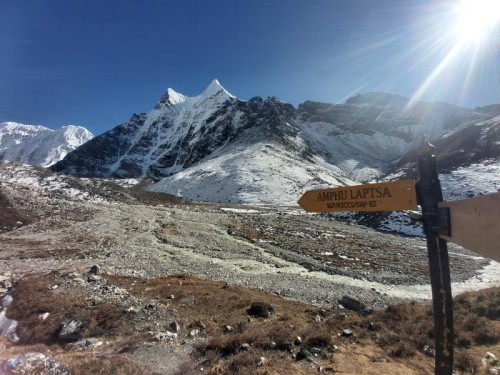


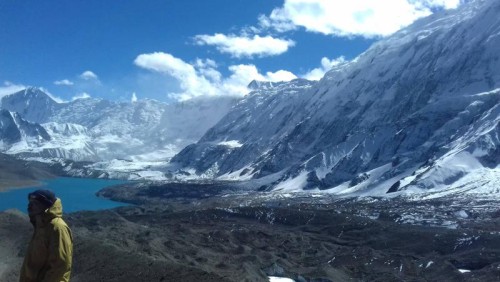
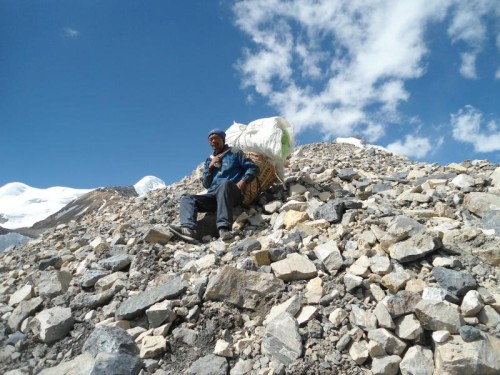
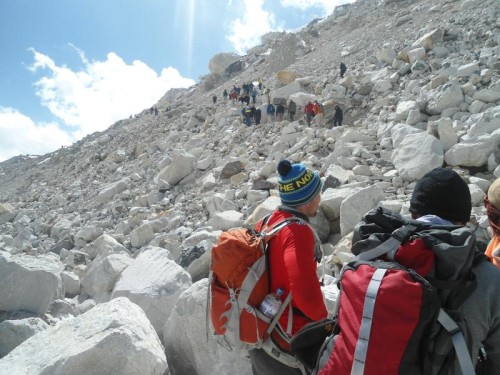
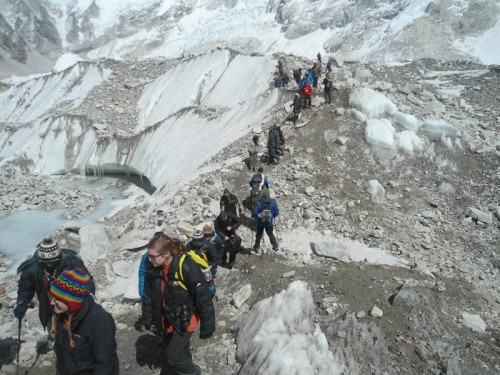

Nike
Germany
Beyond Limits: Conquering Amphu Laptsa Pass
20th June, 2025
I completed a 15-day trek from Lukla to Amphu Laptsa Pass via Mera La, ending back in Lukla. I found the Amphu Laptsa Pass to be one of the most challenging passes in the Himalayan region of Nepal—but it was an absolutely amazing experience. There were two of us in the group, accompanied by one guide and four porters throughout the trek. We stayed in teahouses for most of the nights and camped in tents for three nights during the trip.
The weather was extremely cold, with daily temperatures dropping below zero degrees Celsius from above Khare Camp all the way to Chhukung. There was no electricity available in the remote areas, so I used a solar charger to power my watch, mobile and camera. Thank you to the High Pass Adventure team for making this a memorable journey. Special thanks to our main guide, Rohit, and to Purna, the owner and organizer of the trip. Highly recommended to others!